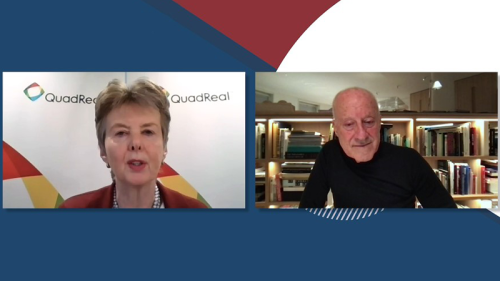Recently, ULI Europe conducted a webinar to discuss how city resilience should be redefined around the world in light of the COVID-19 pandemic in addition to the rising tides threatening coastal cities.
Piet Dircke, global leader, resilience and water management at Arcadis, moderated the discussion, asking Khoo Teng Chye, executive director at the Centre for Liveable Cities (CLC) in Singapore’s Ministry of National Development, to provide an update on the research that the CLC is conducting in conjunction with ULI on five coastal cities that are vulnerable to climate change.
ULI members can access this webinar on demand along with many others in Knowledge Finder.
Khoo said that the five cities—Singapore, Rotterdam, New York, Miami, and Hong Kong—all have different problems and are therefore employing different strategies. In Singapore, for instance, the prime minister recently announced that S$100 billion (US$71 billion) would be mobilized for climate defense over the next 60 to 100 years.
“We have a three-pronged strategy to understand, mitigate, and adapt to climate change,” he said. “At the Singapore workshop for the research, ULI members felt that the real estate industry can play a bigger role beyond just sustainability, but to seriously look at the impact of climate change and how they can better build for resilience.”
In contrast, Rotterdam is taking a different approach to the threats it is facing. “Rotterdam is probably one of the leading cities in the world in terms of making the future climate proof,” said Khoo. “There is the challenge of excess water. In 2006, there was a shift from shutting water out to living with water. There is an emphasis on adaptability in urban design.”
Khoo also highlighted the leadership being shown by property companies in Hong Kong, where the city’s strategy emphasizes stormwater management and carbon mitigation. “Real estate has been ahead of the curve,” he said. “Businesses have brought proposals to government and government has listened. However, industry would benefit from more transparent data. Generally, it is business-led, but there needs to be some government intervention to prevent greenwashing.”
Of course, ULI’s and the CLC’s work started long before the pandemic and Khoo acknowledged that resilience strategies—indeed, all real estate decisions—would have to be revised. “The real estate industry has been badly affected and we will have to review our plans in terms of hospitality, housing—especially senior housing—offices, and retail projects,” he said, noting, “With COVID-19, the cities that have been the most resilient are those that have most prepared, with a whole-society approach and good governance.”
Following Khoo’s presentation, Dircke turned to the rest of the panel to ask about their cities’ experience with the COVID-19 pandemic and how it was informing their approach to resilience. Maria Vassilakou, consultant and former vice mayor of Vienna, said that the city’s underlying social and physical fabric had been a key factor in its widely acknowledged success in tackling the virus.
“Vienna is a city of just under 2 million people and one of the issues with the strategy is our structural diversity,” she said. “It is a city of mixed uses—we have almost no areas that are exclusively office or housing areas. We also have very even socioeconomic distribution. There are no gated communities, no ‘no-go’ areas. It’s what made us very robust through the COVID crisis.”
In particular, Vassilakou referenced the high level of subsidized housing provision and occupation. “It all has to do with the power of social housing distribution in Vienna—62 percent of residents live in subsidized housing and that housing is very high quality, with plenty of space, balconies, and often swimming pools on the roof,” she said. “So, ‘stay home’ was quite easy to achieve, so too was ‘home office.’ Resilience is about flexibility, affordable livability, and strong community.”
Arnoud Molenaar, chief resilience officer at the city of Rotterdam, agreed, adding that his team had identified seven key characteristics of successful resilience strategies. “They include flexibility and inclusiveness, but reflectiveness is getting more and more important. It has been used for the development of our resilience strategy. Right now, we’re in the recovery phase, but also thinking about how we can grow and thrive.”
Specifically, Molenaar said that the city of Rotterdam is reflecting on the wider issues that have been exposed by the pandemic and how they can be addressed to create a more resilient city. “Our view of ‘build back better’ is that it isn’t just focusing on economic recovery,” he said.
“We also have to learn from the crisis and identify vulnerabilities and work toward a strategy where we will be ready for the next crisis—because there will be a next crisis. Part of this is about looking for synergies with measures to tackle the climate crisis.” Creating green spaces on Rotterdam’s rooftops is one such synergy, he added.
For Séverine Chapus, head of development, major mixed-use projects, at BNP Paribas Real Estate in Paris, the key to an effective resilience strategy in the wake of COVID-19 lies in creating cohesive communities. “We can see that resilience is closely connected to social cohesion,” she said.
“Developers more than ever have a responsibility to contribute to inclusive cities. That means affordable housing, but also high-quality living. It’s mixed use at all scales—the house, the apartment, the building, the neighborhood. We have to build for the people who will live in and use buildings.”
Khoo agreed but added that the mix of uses had to apply beyond the neighborhood level. “Mixed use is very important, but how a city is structured is also very important—the traditional structure for a city is having the CBD and then suburbs, but the structure in Singapore is different, with a number of centers where people live, work, and play.”
This, Khoo added, has been beneficial in tackling COVID-19. “The city center did suffer, but the town centers are quite self-contained, so we weren’t as badly affected as we could have been. Going forward, we need to be thinking about urban structures that are more polycentric and self-contained.”
Molenaar added: “We’re looking at how we have to develop. So, yes, it should be multifunctional but also flexible. We’re looking at what happened with the pandemic. We will end up with a lot of empty office spaces, so how can we transform them? It’s not easy, but if a building had been more flexible [in the first place], we would have been better prepared—that is a lesson learned.”
However, despite the challenges, Khoo concluded that the real estate industry should have confidence that collectively it will rise to the challenge globally. “This is an opportunity for the industry,” he said. “The ULI community is responding really well, with webinars in every region. We’re more connected than ever, despite the lockdowns.”



